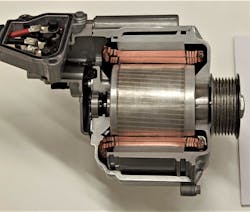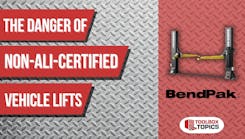There are two primary parts in an HV electric motor. The “rotor” that rotates and provides power, and the “stator” that produces a three-phase rotating electromagnetic field.
The stator consists of electromagnets arranged in a circle. Three HV cables (or bars) attached to the stator provide power to the stator from the inverter. The inverter gets its power from the HV capacitors, and they get their power from the high-voltage battery pack.
What motor types are used in EMVs today? Modern electric drive vehicles (since M/Y 2000 nationwide) in North America use one of two types of motors:
- Three phase alternating current (ac) brushless interior (or exterior) permanent magnet (PM) synchronous motor (98 % of all EMVs)
- Three phase alternating current (AC) brushless induction asynchronous motor (Some Teslas and GM)
Rotor
In a PM motor, the rotor is usually held by bearings at each end of the shaft that the rotor rotates on. In the case of the old IMA (Integrated Motor Assist) Honda system, it is mounted on the end of the crankshaft. The PMs are attached to the rotor in such a way that there is a North magnet(s), then a South magnet(s) and then more of the same. Surrounding the inner (or outer) rotor are many permanently mounted electromagnets. The polarity of the electromagnetic fields (the stator) is switched rapidly by the inverter.
Bearings
One problem that can come up with these types of motors is rotor bearing failure. That can happen when the rotor shaft creates its own current that flows through the rotor bearing at one end and then back to the rotor shaft using the other bearing. Before long the bearings – having lost some metal on the face of the rotating bearing – fail, as the metal is eaten away. To keep that from happening, there are two solutions. One being to add brushes to the rotor shaft to “ground” the electrical charge, or insulate one of the bearing’s inner or outer races to create an open circuit.
Stator
The part of the motor that does not move is the stator. If you look at most stators you will see slotted cores made of thin sections of steel, wound with insulated copper wire to form one magnetic pole, then that same wire is moved opposite that pole to make one more pole 180 degrees away from the original one. There are three windings in each motor that are 120 degrees apart and are labeled U – V - W.
Resolver
When Toyota designed their transmission, with the help of Aisin Corp., resolvers were required to report the position of the rotor before it was rotated. That was a new type of sensor.
Diagnostics for electric AC motors
The inverter powers the AC motors on EMVs. Each M/G has its own inverter. Think of an inverter as a “motor controller.” If the motor cannot work as a generator, then it is just a motor, like an air conditioning compressor. AC motors do not use brushes like some DC motors. Having no brushes means less maintenance and cost. Also, RPM is easier to control on an AC motor, simply because the frequency applied is easier to control. Less frequency, less speed. If the motor is a permanent magnet motor – either an interior or exterior magnet design – the possibility of a magnet breaking into pieces is next to zero, so cross that off your list. The probability of a magnet losing its strength is extremely low and if it did, it would take a very high temperature to demagnetize these strong magnets. The heat required would most certainly melt coil winding insulation, plastic connectors and such. What about the bearings that support the rotor? That possibility is low, but it could happen. A dial indicator would be an appropriate tool there. If you are testing an induction motor (early Tesla and GM eAssist for example), the rotor has no magnets. It also rarely fails. The only thing that may happen is the rotor would scrape the stator if the support bearings failed. This would produce aluminum and copper dust. In turn, that would short the AC to the chassis and the system would set a fault code for a HV leak. Game over.
That leaves the stator as a suspect. The stator can be damaged with heat, poor construction, attacked by acids in old transmission fluid (the stator is often cooled that way), magnetic vibration issues, and loose connections (more heat). The stator is not visible without a lot of disassembly in most cases, so how do we test for a problem there? If it is a PM motor and you can figure out a way to rotate the rotor, it can be easy.
Four options to test the stator
Test 1. Make a three-bulb tester. You will need three old fashioned filament bulbs (for example No. 1587). Using the bulb socket holder, attach two alligator clips to each wire so you have three light bulbs that are the same. Once the three-phase cables have been removed from the inverter, connect the bulbs to the three cables and rotate the rotor. The bulbs should all light up and be the same intensity. If one is dim, verify that the connections are good by changing the positions of the bulbs. A dim bulb indicates low output on one phase.
Test 2. While the bulbs are attached to the inverter, connect a lab scope to the orange cables and watch the amplitude. The bulbs will still light up, but now you can see a wave form. The three phases should all look the same.
Test 3. Using a milliohm meter, make the same connections to the three-phase cables. You may need to look up a specification if the test shows an out-of-balance stator phase. Make sure the three phases are all equal in ohms. This test will help discover shorted stator windings that short to each other in the same phase, short to ground, short to the temperature sensor (if it has one), or shorts to another phase. If the test shows a failure, take the motor apart enough to remove the orange cables from the system and test again at the stator itself. It is possible to have a high resistance connection or bad orange cable and the stator may be OK.
Test 4. This test will make use of your insulation tester. You are now adding high voltage (with very low current) to the stator and attaching the meter’s ground lead to the stator’s case. You are looking for an isolation issue that will show you bad insulation on the coil windings of the stator.
Testing and replacement
The four tests can all be done in under 30 minutes once you know your equipment and have access to the orange cables that feed the AC to the stator. There are two tests for induction motors, tests 3 and 4. When there are no magnets, tests 1 and 2 will not work. Once you have determined the stator is defective, it must be replaced.
There are companies that can rewind a stator, but typically it is replaced with a new one. Some OEMs have designed this for easy removal (or the technician is just lucky) and other OEMs will have you replace the entire assembly.



